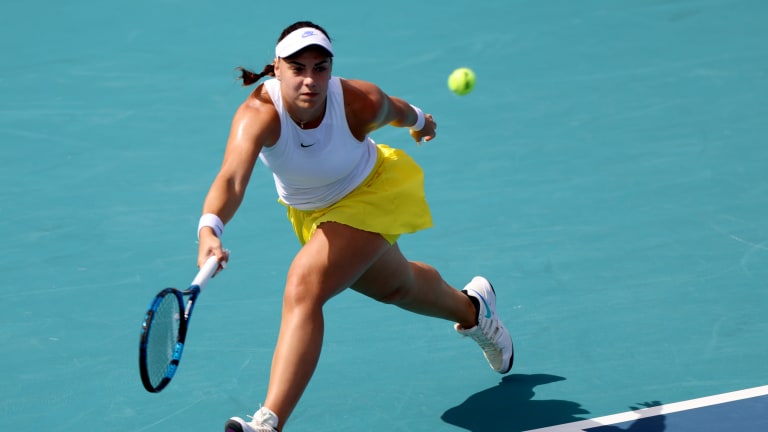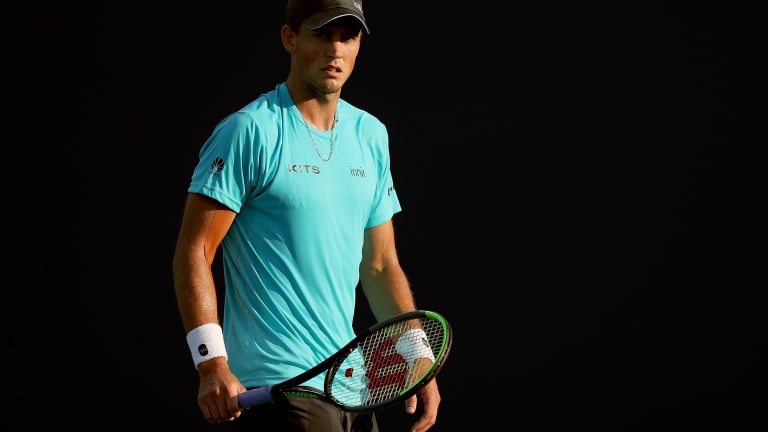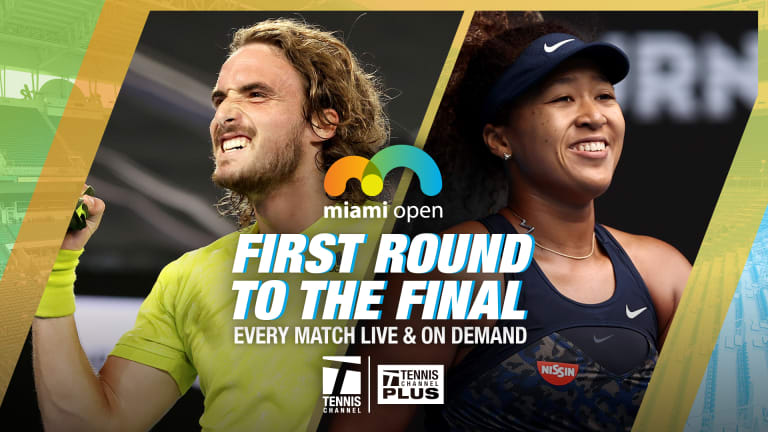The Rally—Controversies, comebacks define Miami; WTA filling Big 3 gap
Mar 29, 2021In beating idol Novak Djokovic, Jakub Mensik came of age in Miami
By Steve Tignor Mar 31, 2025Can Jessica Pegula step out of comfort zone on clay?
By Pete Bodo Mar 31, 2025Jakub Mensik, Miami champion, was going to pull out of the tournament an hour before his first match
Mar 31, 2025Teenager Jakub Mensik denies Novak Djokovic 100th title in Miami Open upset
By TENNIS.com Mar 31, 2025Aryna Sabalenka takes aim at Iga Swiatek's dominance of the European clay season
By Steve Tignor Mar 31, 2025Novak Djokovic vs. Jakub Mensik: Where to watch, and who will win, their Miami Open final
By TENNIS.com Mar 30, 2025Roger Goodell watches on as Aryna Sabalenka defeats Jessica Pegula in Miami final
By Associated Press Mar 29, 2025Aryna Sabalenka masters Jessica Pegula again to win Miami Open
By TENNIS.com Mar 29, 202519-year-old Jakub Mensik to face Novak Djokovic in Miami Open final
By David Kane Mar 29, 2025The Rally—Controversies, comebacks define Miami; WTA filling Big 3 gap
Most of all, what we see at a tournament like the Miami Open is how compelling it is to watch men and women compete at the same event.
Published Mar 29, 2021
Advertising
In this edition of The Rally, Joel Drucker and Steve Tignor talk about the controversies and comebacks that have defined the Miami Open, and how the women have been filling the Big 3 gap.
Hi Steve,
It’s great to see the Miami Open back after not taking place last year. America’s Sunshine Double of Indian Wells and Miami have always been nicely paired—a West Coast desert destination in a laid-back retirement community, followed by an East Coast metropolitan mix of city and ocean. As a California resident since I was 10 years old, I find Florida rather exotic, particularly since I haven’t attended Miami nearly as often as Indian Wells. And though it’s unfortunate to see Indian Wells cancelled for the second straight year, I’m grateful for the chance to take in Miami, even from afar.
There’s an odd but increasingly familiar contrast going on during this event. At one level, we’re all aware of pro tennis amid pandemic conditions, most of all the absence of significant crowd noise—often a major factor in Miami that can sometimes create a soccer-like atmosphere. I vividly recall this from the time I was there in 2007 and saw Argentine Guillermo Canas upset Roger Federer. That’s not happening this year, and it’s striking. But also, by now, six months after pro tournaments restarted, the old saying endures: The show must go on. Perhaps down the road it will be interesting to hear players describe what it’s like to return to competing in front of bigger crowds.
The men’s field offers a distinct look at something we know will happen but don’t want to yet admit: life without reigning champion Federer (four Miami titles), six-time winner Novak Djokovic and Rafael Nadal, a runner-up on five occasions. Naturally, I miss the Big Three and the epic story lines and familiar skill sets they each bring. Their presence is at once comforting and captivating.
But I’m also fascinated to see how such contenders as Daniil Medvedev, Stefanos Tsitsipas and Andrey Rublev step up. And since this spring hard-court stretch has usually been a productive time for Americans, I’ve been paying close attention to Mackenzie MacDonald, Taylor Fritz, Frances Tiafoe, 2018 Miami champ John Isner and, perhaps most intriguing of all, the ascending Sebastian Korda. Saturday night, Korda beat Fabio Fognini—his first Top 20 win—showing a nice range of smoothness and power.
What strikes you so far about Miami, Steve, both inside and outside the lines?

The Rally—Controversies, comebacks define Miami; WTA filling Big 3 gap
© Getty Images
Advertising
Getty Images
Hi Joel,
Since last year’s US Open, the big tournaments have unfolded in similar fashion. As they get underway, and the players do their rounds of pre-event interviews, controversies are generated: about bubble restrictions, mainly, but also about prize-money-reductions and lack of player representation. Then, as the days and matches roll along, these early issues are subsumed and replaced by the stories that the players start generating on court.
We’ve seen that same pattern play out in Miami. It started with bubble complaints—Novak Djokovic withdrew because of them, and other players have chafed under them. Then Vasek Pospisil briefly and memorably took center stage after his mid-match meltdown about ATP chief Andrea Gaudenzi. By the weekend, though, we were talking about Ana Konjuh’s comeback after four elbow surgeries, and Daniil Medvedev’s miraculous cramping-Houdini act—the stuff we come to sporting events to see.
That doesn’t mean Pospisil’s fight with the ATP isn’t important, too. It’s just that for a lot of us, it’s not easy to imagine what role the union that he and Djokovic have tried to form, the PTPA, might play in a tour where tournaments and players are evenly represented. Djokovic himself has said that there isn’t a clear-cut mission or structure to their organization yet, beyond the goals of spreading more wealth among the players and giving them more say-so in how the sport is run.
I don’t think anyone would argue with those objectives, and I wouldn’t argue with the idea of a player union, especially one that brings the men and women together. Player unions have raised salaries exponentially in other sports, but I wonder if the success of the NBA’s—specifically, in negotiating a 50-percent cut of the league’s revenues—has raised expectations for what can happen in tennis too high. In 2012, the ATP’s Big 4 came together to push for more money and fairer scheduling at the Slams, and they succeeded. Right now three of those four—Federer, Nadal and Andy Murray—have declined to join Djokovic’s fight. Maybe it’s too late, or there’s too much water under the bridge, to get that band back together, but I’m guessing they would still have the clout to bring the ATP to the table, and get the players more of what they want while still keeping the peace.
Anyway, that’s a topic for another Rally, or multiple Rallies. For now, there’s actual tennis to talk about. So far I’ve loved the Konjuh comeback, the return of Bianca Andreescu, the continued strong play of Garbiñe Muguruza and Jessica Pegula, the nightly adventures of Frances Tiafoe, and of course Medvedev’s shuffle off to Buffalo. You can also really see how the time away from the tour has made it tough for the players in the Miami humidity.
One first-week trend: When we found out that the Big 3 weren’t going to play, a lot of us looked at it as a chance for other male players to step up and get noticed. But so far I’d say it’s the women who have been filling that gap. Is that a sign of things to come?

The Rally—Controversies, comebacks define Miami; WTA filling Big 3 gap
© Getty Images
Advertising
Getty Images
Steve,
I agree with you that the women have generated a great deal of the interest during Miami this year. Perhaps on the men’s side, the Big Three have dominated for so long that the other excellent players have yet to imprint themselves on our minds. They simply haven’t surfaced in the late stages of that many events yet—not just at Slams, but even at Masters 1000 tournaments. So it’s hard to feel connected with them the way we have for so long been engaged with Djokovic, Nadal, and Federer.
But the wealth has been spread much more among the women in recent years, so I found myself more aware of who they are, familiar with their playing styles, various back stories, and so on.
Most of all, what we see at a tournament like the Miami Open is how compelling it is to watch men and women compete at the same event. To bounce back and forth among these superb ATP and WTA players, to witness dramatic matches from both genders, to take in these various playing styles and personalities—it all adds up to a smorgasbord like nothing else in all of sports, an excellent example of one plus one equaling three. The only thing better than watching it play out on TV is to be on-site, strolling from one court to another, taking in practices, singles, doubles, at once scheduled, at other times, random.
As far as the PTPA goes, I hope its leaders grasp how distinctive tennis is as the only professional sport where both genders compete concurrently at the same event—and how marketing that unique dimension effectively is our sport’s best chance for sustained success. Not all events need to be dual-gender, but a great many should be organized and marketed that way.
I like that Djokovic and Pospisil want to help players gain more representation. And who wouldn’t want a salary increase, particularly if one suspects there’s more money floating around? Let’s then play this out. Let’s even imagine the PTPA doubling prize money. And then what? What does the PTPA intend to do to bring more value for fans, sponsors and, dare I say, media? I look forward to learning more—including how WTA players fit into the PTPA.
This is promising to be such an unusual tennis year, everything from the altered calendar to the bubbles that define many tournaments, all amid the still-present pandemic. The stress is like nothing the sport (or the world) has ever faced, so it will be fascinating to see how the players handle all these challenges. More than ever, I think the non-tennis members of a player’s support team—trainers, physiotherapists, psychologists—will take on an even bigger role, in many cases, greater than the coach.
Steve, based on what you’ve seen in Miami, how do you see the pandemic continuing to shape the tennis world?

The Rally—Controversies, comebacks define Miami; WTA filling Big 3 gap
© Getty Images
Advertising
Getty Images
Joel,
I think your point about what it’s like to have men and women playing at the same events dovetails with your last question, about how the tennis world might be shaped by the pandemic.
Whether some players like it or not, it may just make business sense for the tours to merge and streamline more of their operations. If ticket sales continue to be virtually non-existent for the rest of 2021, consolidation may be the only option.
What I like most about dual-gender events is the way they make tennis seem more like a world than just a league. With men and women both there, it feels like we’re following a set of characters playing a role in a drama, as much as athletes playing a sport.
So far, the character who has developed the most in Miami would seem to be Tiafoe. A guy who has had a reputation for ups and downs, for lapses in concentration, for close defeats, has been finding a way all week; he has lost three straight first sets, and come back to win three straight matches. Now we’ll see him take a step up in weight class against Medvedev.
And I think you make a good point about the PTPA: Can they sell it as something that will be good for fans, rather than just the players? There seems to be a slight trend in favor of unions in the U.S. today. Can the players make the public understand that they’re not uniting so the rich will get richer, but so the sport as a whole will be healthier?
For now, one thing hasn’t changed in 2021: Miami always signals to me that the season is about to get serious. Clay, Roland Garros, grass, Wimbledon; Nadal, Djokovic, Federer, Serena: They're all coming soon.

The Rally—Controversies, comebacks define Miami; WTA filling Big 3 gap